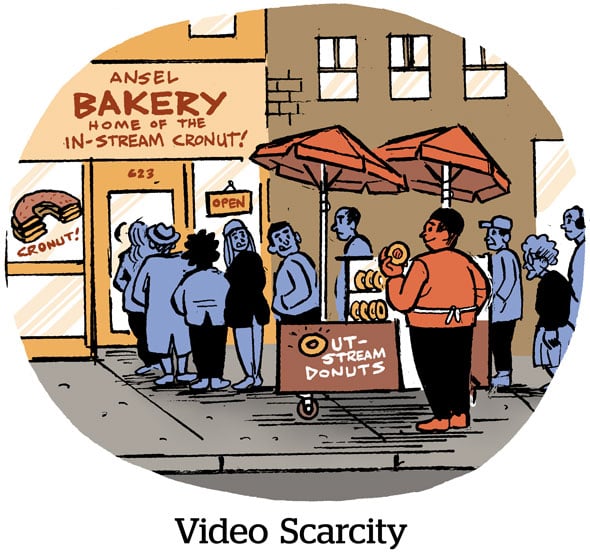Google AdX will update its video policy on April 1 – April Fools’ Day – to reflect new industry standard definitions for instream and outstream video.
Some publishers and video ad platforms are wondering whether the joke is on them.
A large chunk of previously premium inventory – as in inventory that sellers previously sold as “premium” – could soon attract lower CPMs.
To be fair, the new video guidelines are not brand new. They were first released by the IAB Tech Lab in the summer of 2022 and amended with industry feedback last March before being implemented in the OpenRTB protocol. Google first notified publishers about its transition plan for AdX a couple of months later and has since been working to roll it out.
But April 1 is when reality hits.
Google operates the most dominant supply-side platform in the market, and its adoption of these specs is a rubber-hitting-the-road moment for a category of online video platforms whose bread and butter is monetizing a type of video inventory that may no longer be as lucrative as it once was.
The IAB Tech Lab’s new buckets
But let’s rewind.
The Tech Lab updated its video guidelines to be more transparent about the difference between instream and outstream video and to formalize the distinction in a way that can be conveyed in the programmatic bidstream.
Previously, instream was used as a synonym for premium video inventory, said Hillary Slattery, senior director of programmatic product at the IAB Tech Lab.
Yet a lot of what was being classified as “premium” wouldn’t necessarily meet an advertiser’s expectations for premium video, such as pre-roll or mid-roll in an autoplay video that has the sound off by default or floating autoplay videos that appear alongside non-video content. Under the Tech Lab’s new guidelines, publishers can no longer label this type of video as instream within bid requests.
Now, instream only refers to what advertisers describe as a “YouTube-like” experience whereby users arrive on a page expecting to watch a video and, because they initiate playback, the sound is turned on by default.
There is no official “outstream” designation in the new OpenRTB spec; rather, non-instream placements are broken down into three categories: “accompanying content,” “interstitial” and “no content/standalone.”
- Accompanying content refers to pre-roll, mid-roll and post-roll that only begins playback when it comes into a user’s view. Most importantly, the video player also includes some form of publisher-provided content, not just ads. This content is muted by default. The accompanying content designation also applies to video players that load between or after paragraphs of text or images, or an embedded player that converts to a floating player.
- Interstitial refers to video ads that are played without content, cannot be scrolled past and take up the majority of the on-screen view.
- No content/standalone refers to video placements that only show ads without any other content. The format doesn’t matter; it can be a sticky or floating player, a slideshow, a native placement or an in-content banner between paragraphs. This describes what most advertisers picture when they think of “outstream.”
Publishers and SSPs that adopt the new standards must identify whether their video is instream or which of these three outstream buckets it falls into using the new video.plcmt field in OpenRTB bid requests.
Outstream fallout
Before the IAB Tech Lab introduced its new video standards, publishers could – and did – label what is now known as accompanying content as instream in their bid requests, said Eric Hochberger, co-founder and CEO of publisher monetization platform Mediavine.
Many publishers continued to do so on Google’s platform, even as other SSPs made the update.
A good example of accompanying content is when a publisher’s video monetization platform creates video inventory specifically to run ads against. For example, vendors such as Connatix, EX.CO and Primis offer solutions that ingest article copy and combine it with other media assets such as stock video or static images to create monetizable videos. (Accompanying content also includes professionally produced video, not just AI-generated assets.)
The Tech Lab working group that designed the new video standards pushed for the creation of a separate category for accompanying content that would distinguish it from outstream, Hochberger said, because advertisers associate outstream with low-quality placements.
In practice, however, buyers tend to think only in terms of in-stream and outstream, and still consider accompanying content to be on par with outstream, he said.
As a result, publishers testing the new standards in AdX have been seeing their accompanying content revenue crash.
Testing results
Multiple publishers speaking anonymously with AdExchanger said they saw AdX revenue from accompanying content drop by 20% to just over 60%.
One international news site saw revenue from accompanying content drop 63%, while a sports publisher’s revenue fell by 60%. The average decrease across three local news sites was 56%, whereas a financial news site saw a 35% dip, and a travel site saw a more modest decrease of 19%.
However, when accounting for demand from other SSPs, these same publishers experienced a 15% revenue drop on average, which indicates that other SSPs have already made the necessary adjustments.
By this point, most SSPs have implemented the new standards in their bids, said Andrew Fowler, head of revenue operations at ad ops startup Aditude and chairman of the Prebid Video Taskforce.
AdX has been a notable outlier. On April 1, however, once AdX adopts the new guidelines, online video platforms that relied on the industry’s previously mushy definition of instream and outstream video may lose access to one of their largest sources of demand.
What’s next for video monetization platforms?
There are three likely outcomes for what happens when Google flips the switch in AdX just two weeks from now.
YouTube will still be sold at instream’s premium price point, some outstream inventory could become slightly more valuable, and accompanying content may be devalued by advertisers.
The latter could spell trouble for video platforms that specialize in automated video creation for their publisher clients.
But publishers do have other options to offset revenue shortfalls from one video category by prioritizing another. For example, they could create more YouTube-like content that meets in-stream standards.
And if advertisers end up paying roughly the same price for accompanying content as they do for no content/standalone video inventory, publishers could probably serve more impressions – and make more money – by only running ads in their floating video players, said Aditude’s Fowler.
The days of AI-generated accompanying content could therefore be numbered, he said. (Which would be ironic, given the craze around generative AI.)
So how will the video platforms that sell those AI-powered solutions react?
Connatix, which has long specialized in what’s now considered accompanying content, isn’t backing away from the format, said Luca Bozzo, the company’s director of programmatic operations and partnerships.
But Connatix is trying to grow its share of instream by giving users more control over playback and by working directly with publishers on creating content that’s similar to the YouTube experience, he said. Currently, around 10% to 15% of Connatix’s inventory would qualify as instream.
EX.CO continues to offer a service that generates monetizable video content from existing publisher assets, but it stopped actively selling it last year to focus more on monetizing professionally produced video, according to a company spokesperson.
Another video platform that asked not to be named said it would focus more on instream if accompanying content becomes too hard to monetize, and it might even consider rolling out an outstream offering for no-content/standalone placements.
Meanwhile, publishers will have to wait and see how things shake out on the demand side – and they might have to deal with yet another revenue stream getting squeezed until the situation resolves.
A Google company spokesperson told AdExchanger that Google expects AdX’s adoption of the new video standards to “positively benefit both publishers and advertisers by providing clarity on requirements for accurately representing inventory.”
So there you go. Google says everything will all work out just fine. No foolin’.














